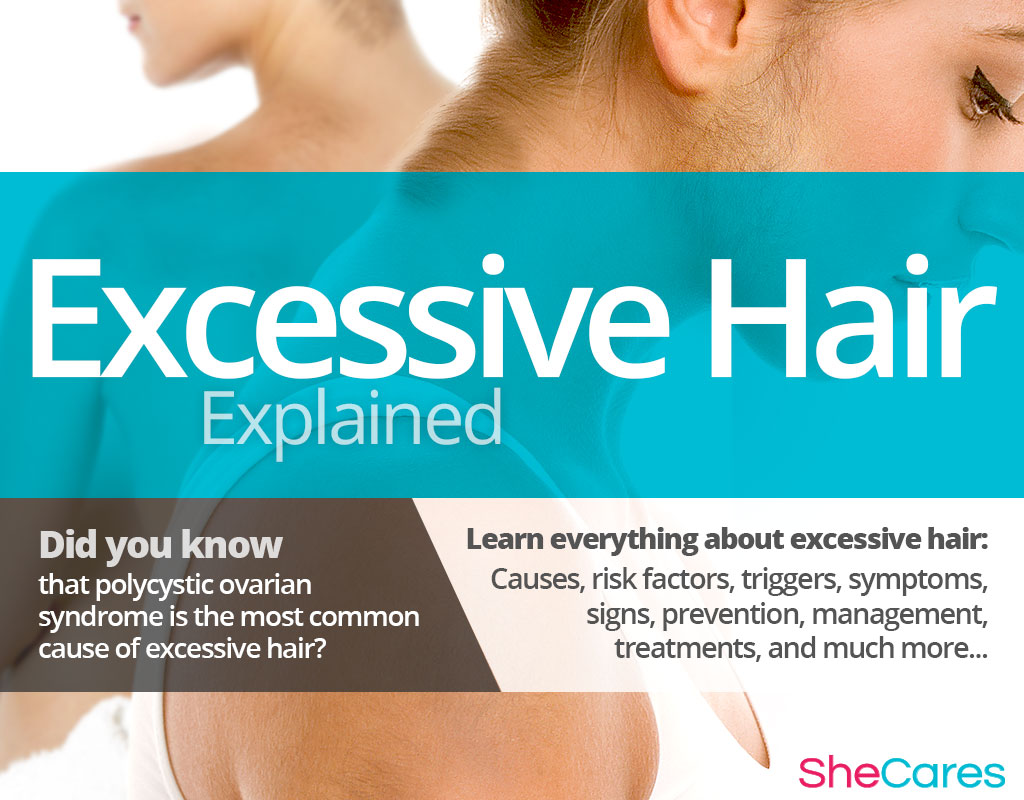About
Quick Facts about Excessive Hair
- About 8% of adult women in the U.S. have experienced hirsutism.
- Polycystic ovarian syndrome is the most common cause behind the appearance of excessive hair.
- 1 in 10 young women are affected by polycystic ovarian syndrome.
The appearance of dark, coarse hair - called terminal or mature hair - on the face, back, neck, and legs is typical of men who have reached puberty, and it is caused by the activity of androgens, or male sex hormones. However, the appearance of terminal hairs on women is much less common, and it is usually caused by hormonal imbalance, specifically an excess of androgens in the bloodstream.
Proper androgen levels are vital for women's health, even if in much smaller quantities than in men, but excessive amounts of them can lead to the emergence of masculine traits, such as the hair pattern seen in hirsutism. Often times, this disorder is a sign of an underlying condition that causes an increased production of androgens, which include testosterone and its precursors.
It is important to note the difference between hirsutism and hypertrichosis, a pattern of excessive hair growth that is not related to an imbalance of androgens. This type of growth occurs in places where hair usually does not grow - such as the forehead and cheekbones - and the hair itself is not like terminal hair, but rather finer and lighter in color. Hypertrichosis is a rare condition and is usually congenital in nature (born with it) or related to an eating disorder or other medications. It is not connected to hirsutism, the male-pattern hair growth that many women experience throughout their life due to changes in hormones.
Significant hormonal fluctuations occur during certain stages of reproductive life, such as puberty, pregnancy, post-partum (including breastfeeding), and menopause. These changes, namely an excess of androgens, can lead to unwanted mature hair growth in women.
Identifying Excessive Hair
The appearance of hirsutism can vary depending on the individual woman and the severity of the underlying hormone imbalance. The most common tool to measure the severity of excessive body hair in women is the Ferriman-Gallwey score that takes into account the areas in which terminal hair is growing as well as the length and thickness of it in each area.
To better understand the source of hirsutism, continue to the next section to learn more about both the hormonal and non-hormonal causes.
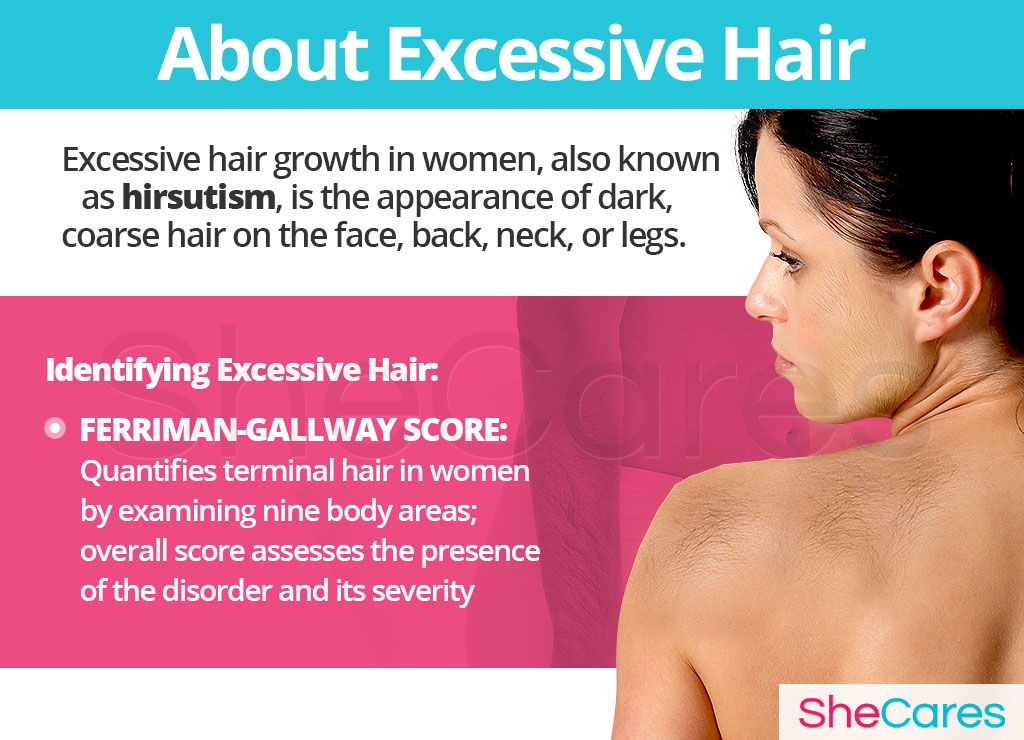
Causes
Knowing about the potential causes behind hirsutism is essential to addressing this sometimes bothersome and embarrassing condition. In the majority of cases, the excessive hair growth is caused by a hormonal imbalance, specifically an excess of androgens in the female body. However, less commonly, another cause could be behind the appearance of unwanted terminal hairs.
Read on to find out more about the hormonal and additional causes of hirsutism.
Hormonal Causes of Excessive Hair
Hirsutism is most often caused by an underlying condition in which the body produces too many androgens. These male hormones stimulate the hair follicles to grow terminal hair. An excess of androgen over stimulates the hair follicles, resulting in the growth of unwanted terminal hair.
The most common of these underlying disorders is polycystic ovarian syndrome, but other less common disorders also can cause an excess of androgens. For example, Cushing's syndrome is a hormonal disease in which the endocrine system produces too much cortisol (the “stress hormone”), which, in turn, causes a disruption in the body's level of sex hormones. (Medications that increase cortisol levels can have the same effect.) Congenital adrenal hyperplasia is a hereditary condition in which the adrenal glands produce an excess of cortisol and androgens. In rare cases, the increased levels of androgens could be caused by a hormone-secreting tumor on the ovaries or adrenal gland.
In addition, it is believed that too much insulin (the hormone that carries sugar to cells) in the bloodstream can cause hirsutism since an excess of insulin may stimulate the ovaries to produce more androgens. Therefore, conditions that involve insulin resistance, or otherwise an excess of insulin, can lead to hirsutism. Such disorders include polycystic ovarian syndrome, type II diabetes, and obesity, among others.
Some medications may indirectly trigger the body to produce a surplus of androgens. These include medicines used to treat nausea, schizophrenia, epilepsy, migraines, high blood pressure, and bipolar disorder. In addition, the pharmaceutical Danazol, which is derived from testosterone and used to treat endometriosis, can disrupt the balance of hormone levels.
There are also specific hormonal causes and signs that can explain excessive hair during a given stage of a woman's reproductive life - such as puberty, pregnancy, post-partum, and menopause. See the boxes below for a breakdown of each of these life stages.
Puberty refers to the period in which a girl's body begins to secrete reproductive hormones. These hormonal fluctuations, as well as other unrelated disorders, can lead to excessive hair in young women.
Pregnancy is accompanied by constant hormonal fluctuations, especially a sharp increase in female sex hormones for the purpose of sustaining the pregnancy and supporting the baby. These changes, in addition to other reasons, may lead to excess hair during this period.
Post-partum is another life stage in which levels of reproductive hormones fluctuate, and this imbalance can lead to disorders such as excess hair or hair loss.
Menopause is the stage in a woman's life when the level of reproductive hormones naturally decreases, and fertility ends. These hormonal changes can often lead to the growth of excess hair, especially on the face.
Other Less Common Causes of Excessive Hair
While hormonal imbalances are the major cause of excessive hair, in some cases, abnormal growth may be caused by other, non-hormonal factors, such as increased androgen sensitivity.
To learn about the potential risk factors and triggers of excessive hair, continue on to the next section.
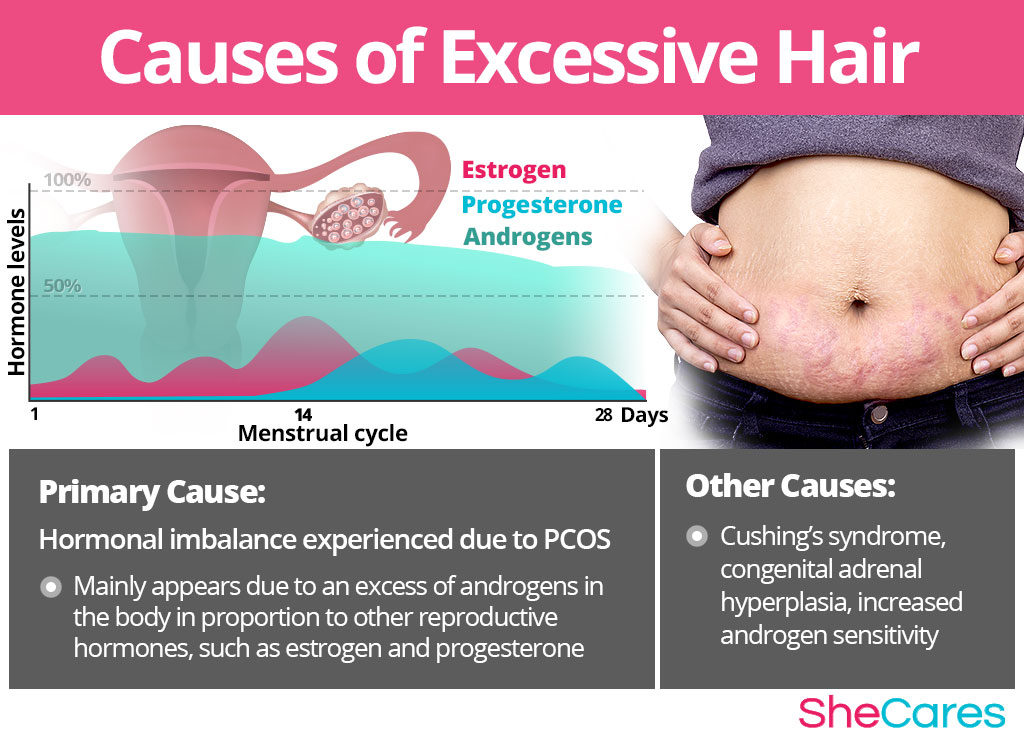
Risk Factors and Triggers
Risk Factors for Excessive Hair
Some women are more likely to experience hirsutism at some point in their lives because of certain risk factors, such as genetics. Some of these factors may affect androgen levels in the body.
Triggers of Excessive Hair
In addition to long-term risk factors, hirsutism can be triggered by the use of certain drugs that increase the body's androgen levels. It is best to avoid these drugs or find an alternative.
Keep reading to find out more about the signs and symptoms of hirsutism in order to be able to select a treatment adapted to its cause.
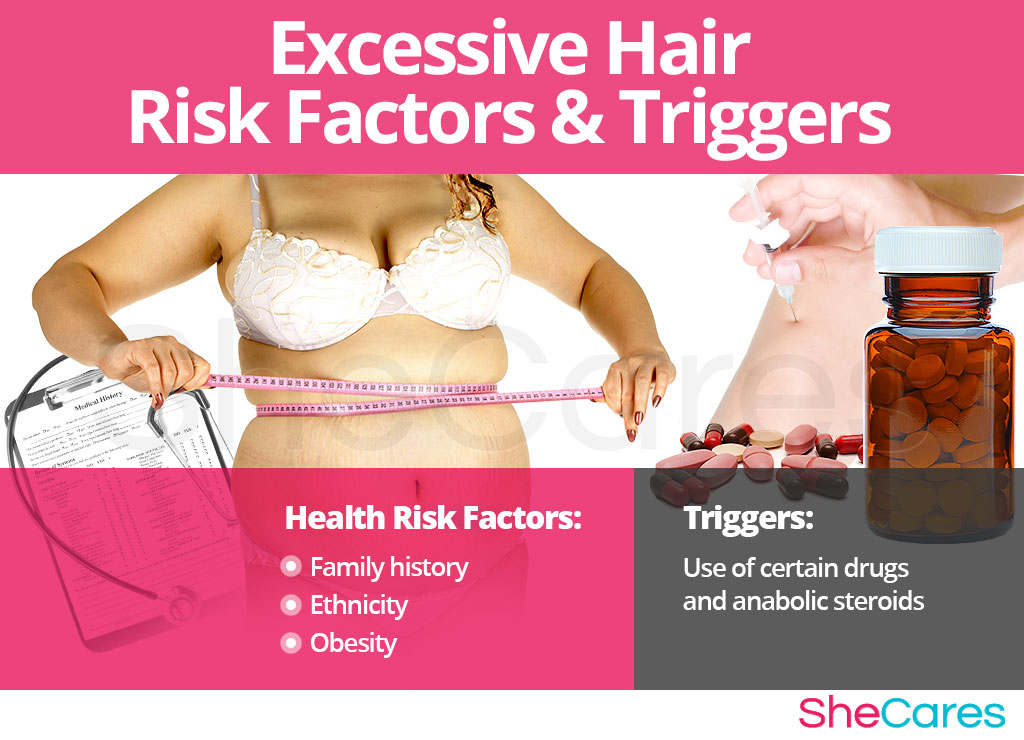
Signs and Symptoms
Because each woman's genes and normal hormone levels are different, experiences with hirsutism will vary from individual to individual. However, many women who suffer from excess hair growth experience other symptoms caused by too many androgens. Women who have male-pattern hair growth on the face, neck, chest, groin, or thighs may also see the following symptoms.
Common Symptoms Associated with Excessive Hair
- Acne
- Smaller breasts
- Deepening voice or other voice changes
- Balding (alopecia)
- Enlargement of the clitoris
- Increased muscle mass
If a hormonal imbalance is causing the excessive hair growth, it may be related to another hormonal disorder, including polycystic ovarian syndrome and Cushing's syndrome. Therefore, other symptoms may accompany hirsutism, such as irregular periods or high blood pressure.
Signs of Excessive Hair
Unlike visible or palpable symptoms, medical signs are criteria that doctors measure and assess. The dermatologist or physician will most likely take signs into consideration when diagnosing the condition.
In male-pattern hair growth, the hair emerges in places where it usually does not appear in women. In terms of quality, the hair is dark, coarse, and thick (terminal or mature hairs) as opposed to thin, light, soft hairs (or vellus hairs) that grow naturally on the arms, cheeks, etc.
The amount of hair growth can be quantified using the Ferriman-Gallwey score. In the modified method, nine areas of the body are examined for male-pattern growth: upper lip, chin, chest, abdomen, pubic area, arms, thighs, upper back, and lower back. Each area is given a score of zero to four, where zero is no hair and four is large coverage. The maximum score is 36, but a score 6 to 14 indicates mild hirsutism while a score of 15 or higher usually indicates moderate to severe hirsutism.
Doctors may also use hair diameter and shaft count as signs, though these are more difficult and more expensive to assess than the Ferriman-Gallwey score.
Diagnosis of Excessive Hair
In order to identify and evaluate the symptoms of hirsutism, a physician or dermatologist will typically review the patient's history, perform a physical exam, and order additional tests when necessary.
Complications of Excessive Hair
In rare cases, hirsutism - and the underlying hormonal condition - can cause complications if left untreated, which pose a risk to a woman's overall health. However, in the majority of cases, hirsutism will not require extensive medical intervention. Some potential, but uncommon, complications of excessive hair include low self-esteem and cancer.
Women who experience embarrassing hair growth may seek ways to treat it or prevent it in the future. Continue reading to learn more about techniques for preventing excessive hair or ways to make it more manageable.
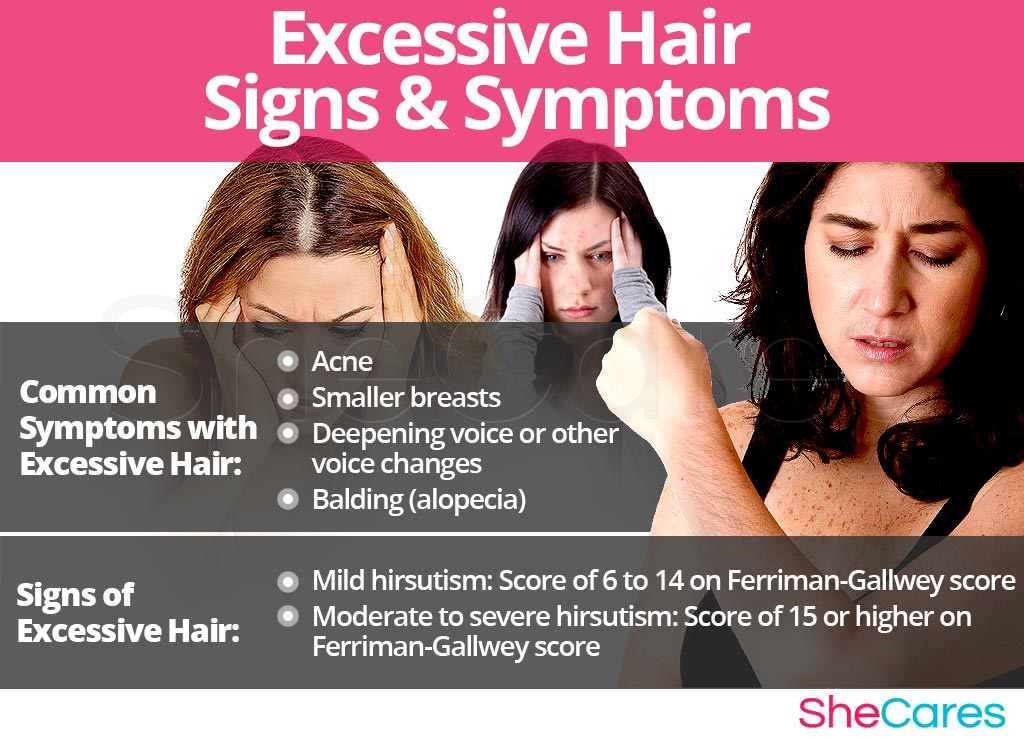
Prevention and Management
Preventing Excessive Hair
While there is no definite way to fully prevent hirsutism, just as there is no way to hold back the body's natural hormonal changes, there are some measures a woman can take in order to reduce the chances of unwanted hair emerging or to limit its appearance.
Lifestyle changes are crucial for prevention, especially regarding diet, exercise, and healthy habits. In addition, women may look for a supplement that helps enhance the endocrine system and relieve hormonal imbalance to complement lifestyle adjustments.
Women who have already experienced the emergence of unwanted terminal hair may wish to control the growth of it. Fortunately, there are several ways to manage hirsutism and remove hair that has grown in. Continue reading to learn some tips for managing male-pattern hair growth.
Managing Excessive Hair
Even after mature hair has grown in, there are effective ways to immediately manage hirsutism. Some simple things a woman can do at home may help remove or hide unwanted hair. These are general suggestions that women of all ages can do, such as shaving and bleaching.
It is important to note that in some women, self-care removal techniques may cause folliculitis, or irritation of the hair follicle. This can be painful and take weeks to clear up, and during that time, no further hair can be removed in the affected area. The best and most effective management techniques will vary from woman to woman, depending on her skin, lifestyle, and personal goals with hair growth management.
Alternative Management Tips for Excessive Hair
Alternative treatments may help some women who are dealing with excessive growth of terminal hair. While they will not address the hormonal imbalance behind hirsutism, they may provide some relief. Such methods include acupuncture and reiki.
While these methods may help reduce the symptoms of male-pattern hair growth, they are unable to realistically treat the root of the matter, which in most cases is a hormonal imbalance involving an excess of androgens. However, there are several natural treatments that can address the hormonal causes of hirsutism. Keep reading to find out more about the different approaches to treating unwanted hair growth.
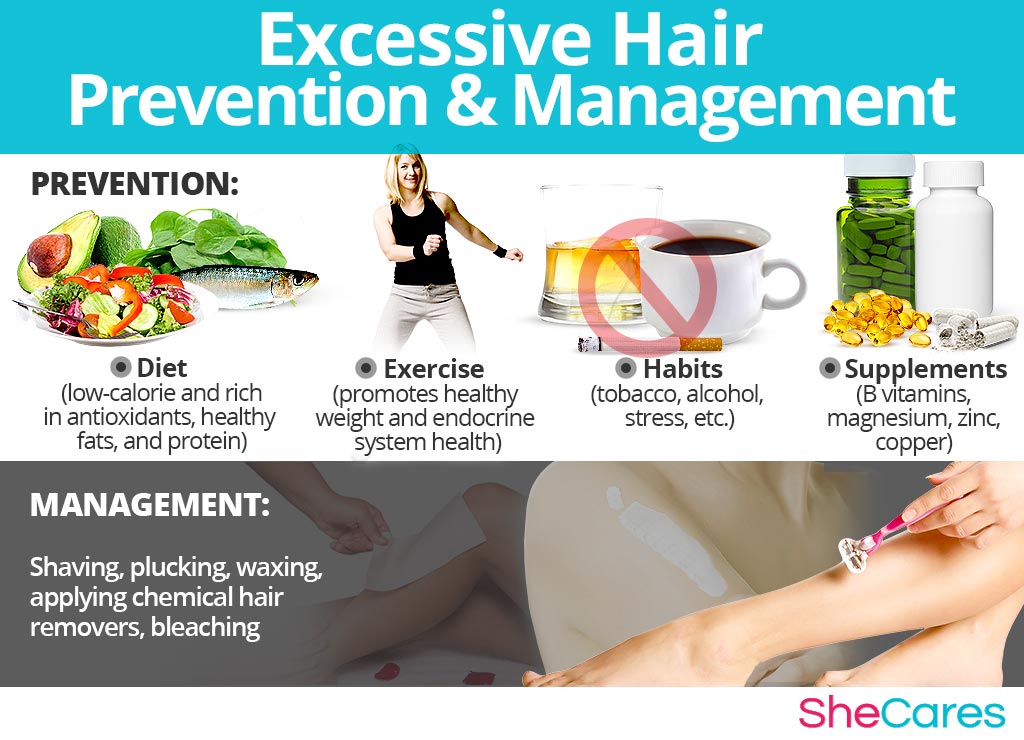
Treatments
Excessive growth of terminal hair, which is most often caused by a hormonal imbalance, can be embarrassing for any woman. Sometimes, the growth is so severe that it may cause both physical and mental discomfort. Fortunately, it's possible for virtually every woman to find an effective treatment for hirsutism.
Three Approaches to Excessive Hair
Three tiers of approaches can be considered for treating hirsutism. These are categorized as: (1) Lifestyle Changes, (2) Alternative Medicines, and (3) Pharmaceutical and Surgical Options.
The least-risky approach to treating excessive hair - lifestyle adjustments - is recommended for women to start with before going on to the next level of care. Medical intervention is usually not necessary for women with hirsutism, but those who are unable to treat their symptoms through lifestyle changes and alternative medicines may consider pharmaceutical options after thoroughly assessing the risks of such a treatment.
Lifestyle Changes for Excessive Hair
The first tier of treatment involves the least amount of risk but requires the most self-discipline. Lifestyle changes can also improve overall health and reduce the risk of obesity and its associated complications. Great health benefits can result from a three-pronged approach to lifestyle adjustments: improved diet, regular exercise, and healthy habits.
These changes may help alleviate excessive hair, but they do not directly address hormonal imbalance, which is the most common cause of hirsutism. Therefore, additional treatment may be required. Alternative medicine has shown to be a safe and natural way of treating male-pattern hair growth linked to an excess of androgens.
Alternative Medicine for Excessive Hair
With little to no risk involved, alternative medicines and supplements can be a highly effective way to treat hirsutism. Regarding herbal supplements, there are two main kinds that can be taken: phytoestrogenic and hormone-regulating supplements.
Phytoestrogenic herbal supplements
These supplements, which contain compounds similar to estrogen but produced by plants, complement estrogen deficiencies. Thus, they can alleviate an imbalance caused by fluctuating levels of female sex hormones.
Supplements like this, such as ginseng, are mainly effective for menopausal women, who typically have lower estrogen levels. They may not be suited for women in other stages of life, such as puberty.
Hormone-regulating herbal supplements
These supplements, such as Macafem, support natural hormone production in the body by nourishing the glands of the endocrine system, which helps the system to work more efficiently and naturally. This ultimately results in an overall balance of hormones in the body.
This kind of supplement can be considered the safest and most natural way of treating the basic hormone imbalance behind excessive hair. In addition, they can be taken throughout a woman's life, since they complement the body's natural hormone secretion.
In addition, some other types of herbal and vitamin supplements can help to treat hirsutism or at least make the symptoms more tolerable and manageable.
Typically, a combination of approaches is the most effective way to treat hirsutism. Alternative medicine combined with lifestyle changes will most likely be the best means to relieve the symptoms of male-pattern hair growth. However, for women with more severe symptoms, the next level of treatment may be necessary.
Pharmaceutical and Surgical Options for Excessive Hair
Treatment at the third tier generally involves the highest risk and often the highest costs. It is best to seek medical advice before beginning any of these treatments for hirsutism since some may not be appropriate for women at every life stage. In addition, most treatments will require a prescription from a doctor.
There are three options at this level of treatment: hormone-regulating medication, hair removal cream, and surgical options.
These three tiers of treatment - lifestyle changes, alternative medicine, and medical options - are not mutually exclusive. Some women may use different treatments at different times or a combination thereof; it all depends on the woman and her symptoms. Many find that the best results and most relief come from a combination of healthy lifestyle choices along with alternative treatments.
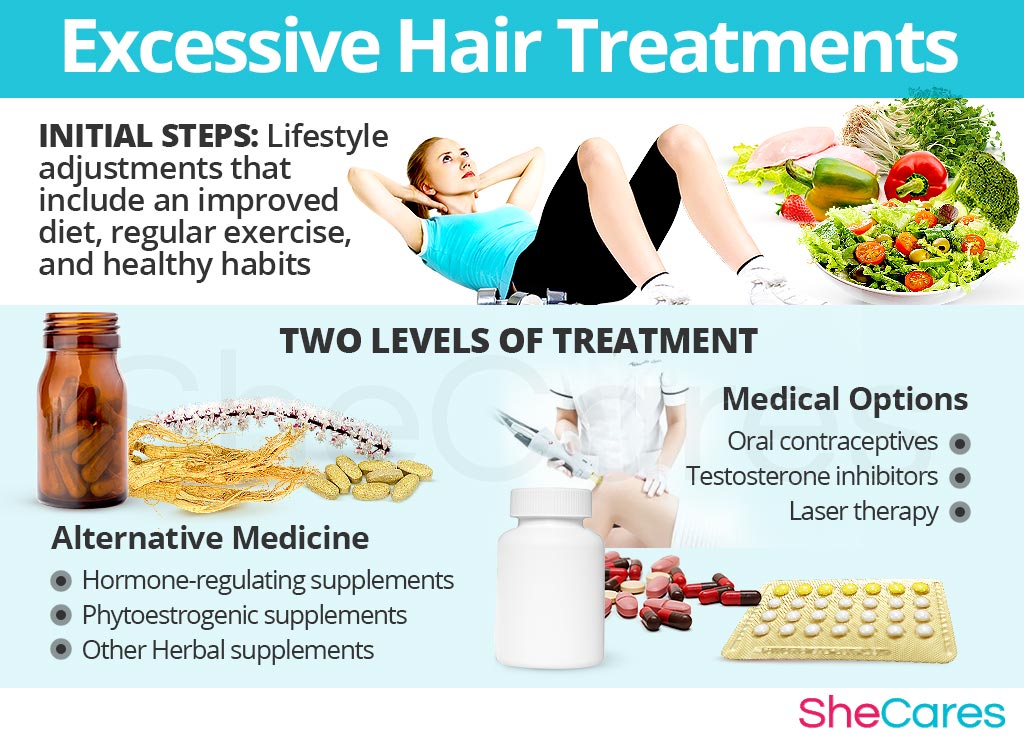
Sources
- Agrawal, N.K. (2013). Management of hirsutism. Indian Journal of Endocrinology and Metabolism, 17(Suppl1), S77-S82. doi: 10.4103/2230-8210.119511
- Bode, D. et al. (2012). Hirsutism in Women. American Family Physician, 85(4), 373-380. Retrieved December 6, 2017, from http://www.aafp.org/afp/2012/0215/p373.html
- Hunter, M. & Carek, P. (2003). Evaluation and Treatment of Women with Hirsutism. American Family Physician, 67(12), 2565-2572. Retrieved December 6, 2017, from http://www.aafp.org/afp/2003/0615/p2565.html
- Mayo Clinic. (2016). Hirsutism: Symptoms & Causes | Hirsutism: Diagnosis & Treatment. Retrieved December 6, 2017, from https://www.mayoclinic.org/diseases-conditions/hirsutism/symptoms-causes/syc-20354935 | https://www.mayoclinic.org/diseases-conditions/hirsutism/diagnosis-treatment/drc-20354941
- Qin, B. et al. (2010). Cinnamon: Potential Role in the Prevention of Insulin Resistance, Metabolic Syndrome, and Type 2 Diabetes. Journal of Diabetes Science and Technology, 4(3), 685-693. doi: 10.1177/193229681000400324
- Sachdeva, S. (2010). Hirsutism: Evaluation and Treatment. Indian Journal of Dermatology, 55(1), 3-7. doi: 10.4103/0019-5154.60342
- Sizer, F. & Whitney, E. (2008). Nutrition: Concepts and Controversies, 11th Edition. California: Thomson Higher Education. Available from Google Books.
- UCLA Health. (n.d.). Hirsutism. Retrieved December 6, 2017, from http://obgyn.ucla.edu/hirsutism
